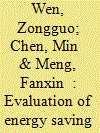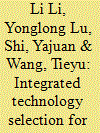| Srl | Item |
| 1 |
ID:
093480


|
|
|
|
|
| Publication |
2010.
|
| Summary/Abstract |
The Korean government plans to increase strategically focused R&D investment in some promising nuclear technology areas to create export opportunities of technology in a global nuclear market. The purpose of this paper is to present a decision support process for selecting promising nuclear technology with the perspective of exportability by using the AHP based on extensive data gathered from nuclear experts in Korea. In this study, the decision criteria for evaluating the export competitiveness of nuclear technologies were determined, and a hierarchical structure for the decision-making process was systematically developed. Subsequently relative weights of decision criteria were derived using AHP methodology and the export competitiveness of nuclear technology alternatives was quantified to prioritize them. We discuss the implications of our results with a viewpoint toward national nuclear technology policy.
|
|
|
|
|
|
|
|
|
|
|
|
|
|
|
|
| 2 |
ID:
137702


|
|
|
|
|
| Summary/Abstract |
Much of China's cement industry still uses outdated kilns and other inefficient technologies, which are obstacles to improving energy efficiency. Huge improvements in energy consumption intensity can be made by improving this technology. To evaluate the potential for energy-saving and CO2 emissions reduction in China's cement industry between 2010 and 2020, a model was developed based on the Asian-Pacific Integrated Model (AIM). Three scenarios (S1, S2 and S3) were developed to describe future technology policy measures in relation to the development of the cement industry. Results show that scenario S3 would realize the potential for CO2 emissions mitigation of 361.0 million tons, accounting for 25.24% of the predicted emissions, with an additional energy saving potential of 39.0 million tons of coal equivalent by 2020. Technology promotion and industrial structure adjustment are the main measures that can lead to energy savings. Structural adjustment is the most important approach to reduce the CO2 emissions from the cement industry; the resulting potential for CO2 emissions reduction will be increasingly large, even exceeding 50% after 2016.
|
|
|
|
|
|
|
|
|
|
|
|
|
|
|
|
| 3 |
ID:
118835


|
|
|
|
|
| Publication |
2013.
|
| Summary/Abstract |
Energy conservation and PAHs (polycyclic aromatic hydrocarbon) control are two challenges for the iron and steel industry, especially where the industry has developed at high speed. How to select appropriate technologies to improve energy efficiency and control pollution from PAHs simultaneously is encountered by both the researchers and the decision makers. This study sets up a framework on technology selection and combination which integrates technology assessment, multiple objective programming and scenario analysis. It can predict proper technology combination for different emission controls, energy conservation targets and desired levels of production. An iron and steel factory in Southwestern China is cited as a case. It is shown that stricter PAHs control will drive the transformation from process control technology to alternative smelting technology. In low PAHs limit, 25% energy reduction is a threshold. Before inclusion of a restraint on energy consumption at 25% reduction, PAHs emission is the key limiting factor for the technology selection; while after inclusion of this restraint, energy consumption becomes the key limiting factor. The desired level of production will also influence the technology selection. This study can help decision makers to select appropriate technologies to meet the PAHs control objectives and energy conservation strategies in energy-intensive industries.
|
|
|
|
|
|
|
|
|
|
|
|
|
|
|
|
| 4 |
ID:
166554


|
|
|
|
|
| Summary/Abstract |
Different scholars have tried to forecast the total cost of ownership (TCO) of electric vehicles (EVs). These studies use different implicit assumptions. This research aims to develop a more comprehensive EV TCO forecasting framework based on a combination of literature review and interviews. The main finding is a framework of 34 factors that influence the future TCO of EVs. By using scenarios, we noticed that the ‘profit margin’ factor seems to be underestimated in current TCO literature. Assuming that in the years to come EV producers want to recoup their investments, we showed that even in a future with much learning and scale effects this does not imply that the TCO of a specific EV will become much lower compared to the TCO of a comparable internal combustion engine vehicle (ICEV). For policymakers this implies that if they want to stimulate the use of EVs they might also need to put policies (e.g. tax policies) in place to increase the TCO of ICEVs. Another policy implication of our analysis is that EV stimulating policies seem to require a long-term effort. EV manufacturers and dealers might be tempted (or even ‘forced’ by shareholders) to increase EV prices rather quickly.
|
|
|
|
|
|
|
|
|
|
|
|
|
|
|
|